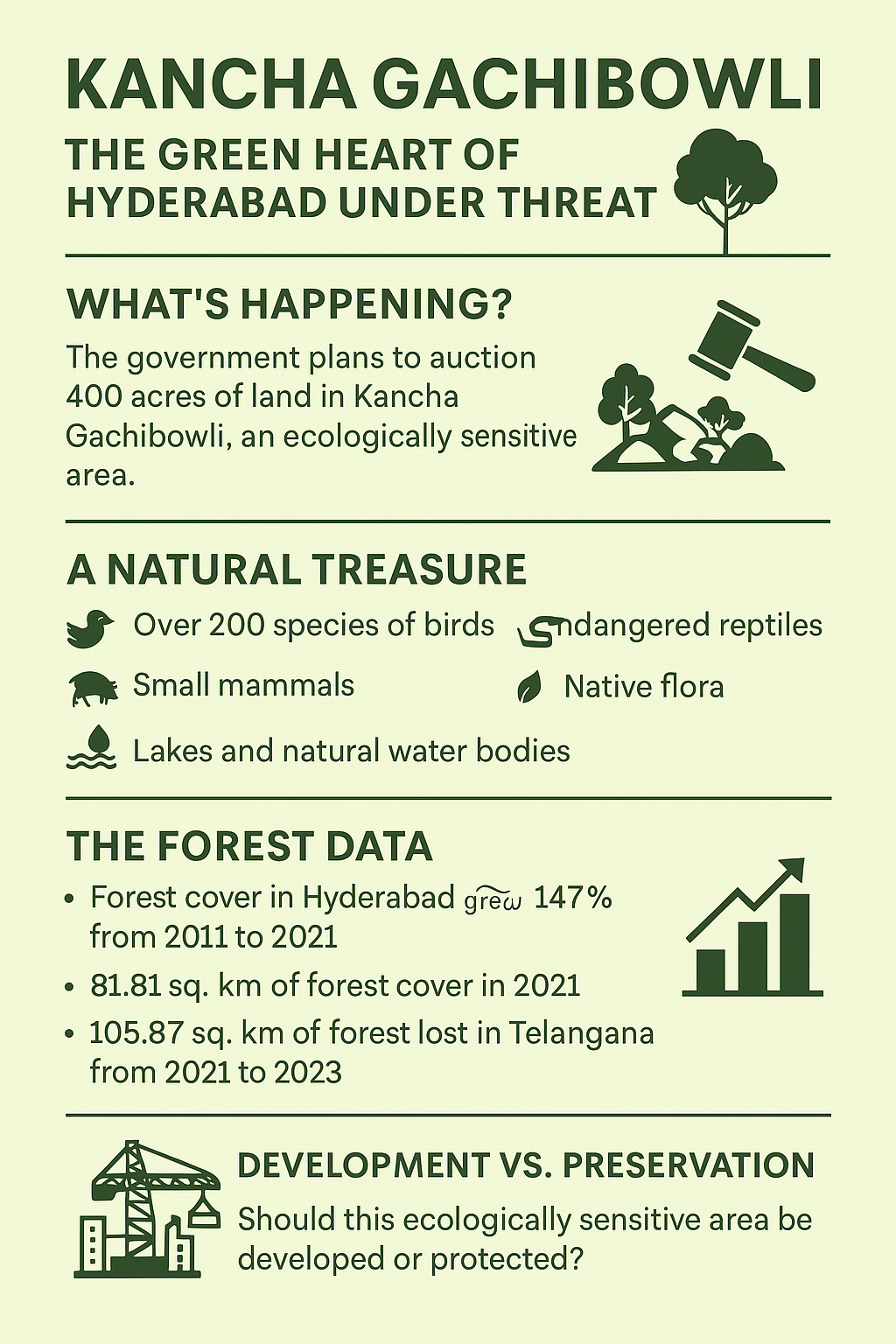Kancha Gachibowli: The Green Heart of Hyderabad Under Threat
Introduction
In the ever-expanding urban sprawl of Hyderabad, a forested patch in Kancha Gachibowli has emerged as the latest flashpoint between development and conservation. Known for its quiet trails, rocky terrain, and rare biodiversity, this green expanse is now facing the axe — literally and figuratively — as the Telangana government moves forward with the Kancha Gachibowli forest auction, targeting 400 acres of land in the area. But is it just “vacant land” ripe for real estate, or is this a last-resort sanctuary that deserves protection?
Kancha Gachibowli Forest Auction: What’s Really Happening on the Ground?
The Telangana State Industrial Infrastructure Corporation (TSIIC) has reportedly initiated plans to auction approximately 400 acres of land located beside the University of Hyderabad campus. The area is currently undeveloped, featuring rocky plateaus, natural lakes, dense shrubs, and mature trees — all of which collectively form an hyderabad urban forest ecosystem.
The land is estimated to fetch upwards of ₹10,000 crore in bids, given its location within the IT corridor and proximity to major tech parks. But what’s being seen as a goldmine for developers is being mourned as a graveyard for biodiversity by environmentalists and residents.
Green Cover Under Threat
Over the past year, multiple reports have emerged of large-scale tree felling in and around Hyderabad—particularly in areas like Kothaguda, Narsingi, and the peripheral zones of the forest blocks near the Outer Ring Road. These areas were once considered crucial for maintaining ecological balance and acting as green lungs for the city. Satellite images and ground surveys indicate significant loss of green cover, attributed to “development projects” like road widening, real estate expansion, and infrastructure ventures.
A Natural Treasure
Kancha Gachibowli is not just open land; it is an ecologically sensitive zone. According to local nature groups, the region supports:
-
Over 200 species of birds, including migratory visitors
-
Endangered reptiles like the Indian rock python and star tortoise
-
A variety of small mammals like mongooses and wild boar
-
Native flora that stabilizes soil and helps groundwater recharge
-
Lakes and natural water bodies that regulate microclimates
This patch functions as a carbon sink, cooling the surrounding areas and filtering dust and pollutants — a natural service that’s hard to price, but crucial in a city like Hyderabad that is heating up year after year.
Congress Government’s Role
Critics argue that the Congress government has prioritized short-term development gains over long-term environmental sustainability. While officials claim that these projects are essential for improving urban infrastructure and boosting economic growth, opponents argue that the environmental clearances have been rushed and public consultations sidestepped.
In particular, the controversial clearance of forested zones for luxury housing and commercial complexes has raised eyebrows. Allegations have surfaced that certain decisions were made under pressure from influential builders and corporate lobbies with vested interests.
Why the Protest?
Local residents, environmentalists, and students have rallied under campaigns like #SaveKanchaGachibowli and #SaveCityForest, demanding that the government withdraw the auction plan. Their key arguments:
-
The area qualifies as “forest” under the Supreme Court’s expanded definition, which includes uncategorized wooded land.
-
The auction violates the spirit of sustainable development and contradicts Telangana’s own Haritha Haram afforestation goals.
-
Once concrete replaces greenery, the loss is irreversible — and future generations will pay the price.

The Forest Data
To understand the broader context, here’s a quick look at Hyderabad’s forest cover:
-
In 2011, Hyderabad had just 33.15 sq. km of forest area.
-
By 2021, after various greening drives, this grew to 81.81 sq. km — a 147% increase.
-
However, Telangana lost 105.87 sq. km of forest cover between 2021 and 2023 (as per the State of Forest Report 2023).
-
If urban forests like Kancha Gachibowli are not protected, Hyderabad’s gains may reverse rapidly.
Development vs. Preservation: Can We Have Both?
The government has stated that development is necessary for economic growth — and that some green features will be preserved within the new plans. But history has shown that once the bulldozers arrive, biodiversity rarely gets to stay.
Many experts now advocate for a hybrid approach — conserving critical green spaces while pushing development into less ecologically sensitive areas. Declaring Kancha Gachibowli a protected urban forest reserve or extending UoH’s eco-sensitive buffer zone could be a starting point.
The Environmental Impact
The consequences of this unchecked deforestation are already being felt. Hyderabad has seen a noticeable increase in temperature extremes, urban flooding, and reduction in groundwater levels. Wildlife that once inhabited the forested regions is being displaced, leading to increased human-animal conflict in suburban areas.
Ecologists warn that if this trend continues, Hyderabad could face irreversible damage to its ecosystem within a decade.
What Needs to Change
It’s clear that a balance between development and conservation must be struck. Experts recommend:
-
Comprehensive Environmental Impact Assessments (EIAs) for all projects
-
Transparent public hearings before approvals
-
Reforestation and compensatory afforestation initiatives
-
Strict penalties for illegal tree cutting
-
Encouragement of green urban planning and vertical development over horizontal sprawl
Final Thoughts
Kancha Gachibowli isn’t just about land — it’s about vision. Do we see Hyderabad as a glass-and-concrete tech metropolis with isolated parks, or as a balanced urban habitat where nature and people coexist? The auction decision will answer that question.
This isn’t just a local issue — it’s a national conversation about what kind of cities we want to live in.


